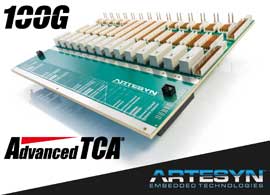Innovative QuadStar™ backplane architecture enables 1.6 Tb/s aggregate bandwidth now, with a future-proof path to 4 Tb/s

HONG KONG [22 October, 2014] —Artesyn Embedded Technologies announced the successful testing of the industry’s first 100G ATCA technology. This breakthrough will for the first time enable bandwidth-hungry next-generation applications in software defined networking (SDN) and network functions virtualization (NFV) deployments to achieve up to 4 Tb/s aggregate throughput in a single open standards-based bladed server system. Working with connector manufacturer, ERNI, Artesyn has developed the critical technology components – the connector and backplane – that enable 100 Gb/s Ethernet connectivity in an ATCA shelf. The technology will be available in Artesyn’s Centellis™ 8000 series systems later in the year and the first applications set to take advantage of this breakthtrough are SDN/NFV network security and optimization, where deep packet inspection techniques are used to process massive data flows in real time.
Artesyn is implementing an innovative QuadStar™ backplane architecture to provide four independent networks to every blade. With today’s 40G payload and switches, this allows customers the flexibility to implement 160G per blade bandwidth with no redundancy or a 120G per blade backplane if one network is used to provide redundancy. That equals an aggregated system bandwidth of 1.6 Tb/s when implemented with no redundancy. This same QuadStar™ technology can be applied to 100G payload and switches. This gives customers the ability to deliver up to 400G to each blade (4.0 Tb/s aggregate system bandwidth) in a non-redundant implementation or 300G with redundancy. To future proof their investment, customers can implement with 40G technology today and achieve up to 1.6 Tb/s of aggregate system bandwidth then upgrade to 100G and achieve up to 4.0 Tb/s of aggregate bandwidth in the future using the same chassis and backplane.
Doug Sandy, embedded computing chief technology officer, Artesyn Embedded Technologies, said: “Working with the industry, Artesyn is facilitating the development of open standards around 100G ATCA, which enable customers to evolve their SDN/NFV platforms to the highest possible performance. Through the companies in our heritage, including Pro-Log, Motorola Computer Group, Force Computers and Emerson’s Embedded Computing business, Artesyn has a long history of contribution to specification development and contribution to the electronics and embedded community. We have been one of the top contributors to the ATCA specification and our leadership in 100G ATCA technology underlines that effort.
“What’s more, we’re enabling customers to future-proof their technology investment by making the 100G shelves available as soon as possible so they can avoid having to ‘rip-and-replace’ their shelves when the 100G payload blades become available. We followed the same philosophy in the migration from 10G to 40G and it’s one of the reasons Artesyn now has the largest installed base of ATCA technology in the world,” continued Sandy.
Artesyn has published a new white paper, 100G+ on a Standard Platform, that discusses the drivers and challenges for meeting service provider demands for more bandwidth and more intelligent networks.






